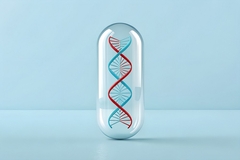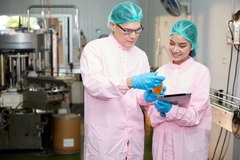Scientists uncover that babies’ gut bacteria may influence future emotional health
Key takeaways
- The makeup of a child’s gut bacteria at age two links to their risk of anxiety and depression symptoms later in childhood.
- More bacteria from specific groups indicated a higher risk of later symptoms.
- The early gut microbiome is tied to differences in emotion-related brain networks, which then predict later symptoms.

A new study reveals how a child’s early gut microbiome may influence their risk of developing depression, anxiety, or other internalizing symptoms during childhood. According to researchers at the University of California, Los Angeles (UCLA) Health, US, the effect relates to the way bacteria affect communication across emotion-related brain networks.
The observational study found that young children with a higher amount of gut bacteria in the Clostridiales order and Lachnospiraceae family were more at risk of experiencing internalizing symptoms — an umbrella term that covers symptoms of depression and anxiety — in middle childhood.
However, this appears to be an indirect connection. The early life microbiome composition was associated with differences in connectivity across different emotion-related brain networks that are related to anxiety and depression later in childhood.
The findings suggest that early gut bacteria play a role in programming brain circuits tied to emotional health later in childhood.
“If unaddressed, symptoms of depression and anxiety can carry a higher risk of mental health challenges persisting as children develop into adolescence and adulthood,” says study senior author Dr. Bridget Callaghan, associate professor of Psychology at UCLA.
“By linking early-life microbiome patterns with brain connectivity and later symptoms of anxiety and depression, our study provides early evidence that gut microbes could help shape mental health during the critical school-age years,” Callaghan elaborates.
Gut microbiome’s “cascading effect”
Most previous research on the gut-brain axis in children has focused on infants and toddlers, rather than school-aged children. Typically, these studies examined how microbial composition may relate to early brain development involved in movement, language, and learning rather than mental health.
Callaghan and her team set out to determine whether the makeup of a young child’s gut microbiome could have a “cascading effect” on mental health outcomes in later childhood, which is when issues such as depression and anxiety first appear.
The study is based on data collected from the “Growing Up in Singapore Towards Healthy Outcomes” (GUSTO) study. That particular longitudinal birth cohort study collected various health data from children in Singapore, including stool samples at two years, resting-state MRI brain scans at age six, and survey insights from caregivers about the children’s behavioral problems at 7.5 years.
.jpeg)
The findings suggest that early gut bacteria play a role in programming brain circuits tied to emotional health later in childhood.
UCLA cohort
The UCLA Health study analyzed data from 55 participants in the GUSTO study. The findings are published in the journal Nature Communications.
The researchers performed a statistical analysis on the data to identify combinations of brain connectivity patterns among children aged six that were most strongly associated with internalizing symptoms reported at age 7.5 years.
Researchers then examined how early gut microbial profiles among two-year-olds were linked to those brain patterns.
The connection between internalizing symptoms and Clostridiales and Lachnospiraceae bacteria populations was similar to that found in research on the adult microbiome and mental health.
These two microbe groups have been linked to stress response and depression in adults as well as to the effects of early childhood adversity, notes Callaghan. Some of these microbes may be more sensitive to stressors, which could explain their correlation with internalizing symptoms in later childhood.
Callaghan says future experimental research will reveal whether these associations are causal and should be acted on.
“We need to figure out what species within these larger groups are driving the findings,” she underscores. “Once we have that information, there are relatively straightforward ways to change the microbiome, like probiotics or diet, that we could use to address issues.”
In an exclusive Nutrition Insight webinar, Lallemand and dsm-firmenich recently showcased insights on targeted synbiotics to boost infant microbiome health.












